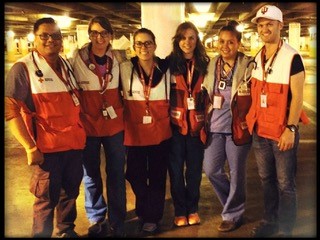
Growing up just north of Miami, Florida, Ashley Collins Roy was accustomed to experiencing some of Mother Nature’s wrath, including significant weather events such as hurricanes. So as this University of Iowa College of Nursing alumna watched the devastation unfold as Hurricane Harvey made landfall in coastal Texas, she immediately knew she wanted to be a part of the recovery efforts.
“As a kid growing up in Florida, you remember that kind of devastation. As I watched Harvey’s destruction on TV, I knew I wanted to help,” said Collins Roy (DNP ′15).
With a flexible work schedule, and the full support of her husband, Collins Roy contacted the Red Cross. “I just wanted to help people who were in need,” she said. But being able to lend a hand to those in need would take some time … 10 days to be exact … as the Red Cross was processing applications from more than 5,000 nurse volunteers who shared a similar desire to engage in the relief efforts.
On Labor Day (September 4), Collins Roy found out her application was accepted and spent a few hours completing some online courses (mostly learning about Red Cross methodology) before booking a flight to Texas.
A day later, Collins Roy reported to Houston where she was quickly assigned to a “mega shelter” in Dallas. In this 3,000-person shelter, Collins Roy and approximately 9 other Red Cross medical volunteers performed crisis intervention – literally going from cot to cot to determine if there were any emergency medical needs, including needs assessments of 75 total care patients who required full assistance with everything from using the bathroom to bathing.
“It was like Maslow’s Hierarchy of Needs coming to life,” described Collins Roy, referring to the renowned five-tiered psychology model that depicts a theory of human motivation. “It was different than I expected because, although you’re applying your nursing knowledge, you’re not necessarily practicing nursing.”
To expedite the assessment process, the team of nurses divided into sections. Collins Roy, who has a background in pediatric nursing, was eventually assigned to the family section of the mega shelter. She worked the night shift, from 7 p.m. to 7 a.m., for four days until she was diagnosed with influenza, abruptly ending her ability to volunteer.
“My drive to help as many as I could at the shelter resulted in me failing to consider the timing of my trip in relation to flu season,” said Collins Roy, who had not yet received her annual flu vaccine. “I absolutely don’t regret it and would definitely do it again … just with a few extra precautions I didn’t take last time. I’m just disappointed my time was cut short.”
On August 25, 2017, Harvey made landfall near Rockport, Texas, as a Category 4 Hurricane, with winds in excess of 130 mph, according to The Weather Channel. Harvey meandered around southern Texas, eventually weakening to a tropical storm; however, even as a tropical storm, Harvey generated 40-61 inches of rainfall in Southeast Texas and Southwest Louisiana, causing catastrophic flooding in the region. All-time U.S. tropical cyclone rain records were broken and Harvey displaced tens of thousands. The Texas Department of State Health Services reported as of October 13, 2017, the death toll from the storm was 88.
Collins Roy currently lives in Meridian, Mississippi, where she recently accepted a new position as a nurse manager of the telemetry floor at Rush Foundation Hospital, a 215-bed community-based acute care medical facility.
# # #